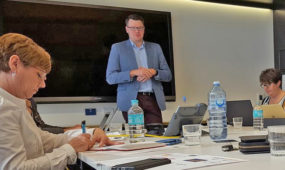Fact File: Adelaide Oval
Ideas
THE redevelopment of the Adelaide Oval has been a delicate process of modernisation, balancing the integrity of the historic ground with the renewal of the surrounding inner-city.

Sign up to receive notifications about new stories in this category.
Thank you for subscribing to story notifications.
Built in 1871, the South Australian oval has long been considered one of the most picturesque test grounds in Australia.
A $535 million commitment from the South Australian State Government in 2009 launched the redevelopment of the oval.
Baulderstone won the construction contract, a demanding job that required large parts of the Oval and Western Grandstand to remain operational throughout the build.
Seating capacity in the oval has increased from 34,000 to 50,000 with several other important upgrades taking place that allow the oval to be used for major football, cricket, rugby, and soccer games, as well as large entertainment events.
Many of the Oval’s iconic features have been retained in the development, including the heritage-listed scoreboard, the grassy northern mound seating and the Moreton Bay figs that adorn it.
Adelaide Oval – The Heart Of It AllKOJO.
The aspects that gave the ground its scenic reputation are being preserved as well; views of St Peter’s Cathedral, the Parklands and Riverbank precincts remain.
The surrounding Riverbank area is undergoing revitalization, including a footbridge that stretches over the Torrens River from the Adelaide Oval to a concourse leading to the Adelaide Railway Station.
The plan is for large crowds and audiences to be funneled directly in to the Adelaide CBD after a game, an economic boon to service businesses in the city.
Before the turf was laid down during the Oval's development. Image courtesy of the Alexander Pacific Group.
The nearby Parklands will receive a boost too, with new furniture, landscaping, and improved management.
Both of the Adelaide based football clubs, the Adelaide Crows and Port Adelaide will be based at the upgraded facilities.
On top of Australian Rules Football, Cricket will be making a big comeback at the Adelaide Oval with India playing Pakistan on February 15th, 2015.
There is a new indoor cricket training centre inside the complex featuring indoor nets, a high performance gym and player facilities. Footballers will likewise have access to revamped change rooms.
The ground will be FIFA compliant, meeting lighting, field, media and player facility requirements, however temporary stands will need to be constructed on the northern mound for FIFA games.
The Oval will also house the Bradman Collection, an exhibition containing cricket memorabilia from 1927 to 1977, covering the entire life of the legendary cricketer, Donald Bradman, who made Adelaide his home.
Trial by fire: The first showdown played at the renewed Oval
The first AFL game played in the new Oval took place on Saturday the 29th of March. By all accounts the Oval's atmosphere was unmatched, with tens of thousands of fans turning up to see the game.
Australian Rules Football is a game of numbers, but in this case some of the numbers might be a little surprising:
50,397 people attended the Football game. The new footbridge was crossed 52,000 times. Of the attendees, around 35,000 used the public transport network to attend – which included free bus, tram and train rides on the day of the game for ticketholders. 5,700 hotdogs were consumed, 3,000 pies were sold, 2,000 sandwiches, 26,000 soft drinks, 10,000 bottles of water, 1,000 churros, 4,500 corporate meals were served, 1.7 tonnes of potatoes were used and 200kg of coffee beans. The Oval is expected to boost the state economy by around $100 million every year.
It was a trial by fire, but the new Adelaide Oval performed admirably.
There were some troubles with the buses, trains and trams due to high demand, but the target of 70% of attendees using public transport to attend games was nearly reached on its first day.
That's a big improvement on the average of 23% at AAMI stadium.
Surrounding service and retail outlets were the big winners after the game, with thousands of new patrons flocking in to the city before and after the game, many traders reporting New Years Eve levels of activity.
The Adelaide Oval, second day of the third test between Australia and England, 20th January 1902. Australia won by 4 wickets. Image courtesy of the State Library of South Australia.
History of the Adelaide Oval
The ground was established in 1871. The Oval’s first test match was played from 12-16 December in 1884. England beat Australia by eight wickets. The first football game lit by electric light was played at the oval in 1885 with lamps made by Siemens. The game had a good attendance, but there were several lighting failures and the ball’s white paint faded over the game making it harder to see. The historic scoreboard was put in to service on the 3rd of November, 1911. In 1931-1932, Donald Bradman scored the highest test score at the ground with 299 against South Africa. Clarrie Grimmett also collected fourteen wickets, the record for a bowler at the ground. The bodyline affair, a nasty tactic devised by the English team to thwart Bradman’s legendary batting skill, reached a low point in 1932, with several players struck. Mounted police had to keep the record crowd in order. In 1947-1948 Australia scored 674 against India, still the highest team total at the ground for test cricket. David Bowie played his first concert in the Southern Hemisphere at the Adelaide Oval in 1978. It was also his first large outdoor concert. In 2003, two matches of the Rugby World Cup were played at the oval. In the first Australia beat Namibia 142-0. The second was a little closer – Ireland won out against Argentina by a single point. 2009 marked the commitment to redeveloping the Adelaide Oval. 2014 will see the completion of the redevelopment, and the return of the Adelaide Oval as a premier location for sports and entertainment.Adelaide Oval cricket, showing the members of the Southern Cricketing Association Team, 13th March 1903. Image courtesy of the State Library of South Australia.Adelaide Oval redevelopment timelapse, courtesy of the Department of Planning, Transport and Infrastructure.
South Australian Cricket Association (SACA)
Baulderstone Adelaide Oval Project Brief (.PDF)
Jump to next article



